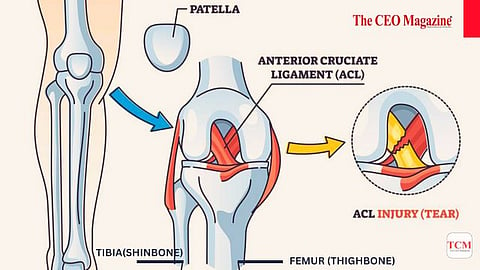
- News
- Women
- Magazine
- IndustryIndustry
- InsightsInsights
- Success Stories
- PublishPublish
- ContactContact
- Media KitMedia Kit

Anterior Cruciate Ligament
Causes, Symptoms, Treatment, and Prevention
ACL injury, a short form of Anterior Cruciate Ligament injury, is a common problem affecting the knee joint. This injury happens when the anterior cruciate ligament, which connects the thigh bone to the shinbone, gets torn or sprained.
It's frequently seen in sports that involve sudden stops, changes in direction, jumping, and landing, like soccer, basketball, football, and skiing.
This guide aims to provide a comprehensive overview of ACL injuries, covering their anatomy, causes, symptoms, diagnosis, treatment, and prevention strategies.
The knee joint is a complex structure formed by the meeting of three bones: the femur (thighbone), tibia (shinbone), and patella (kneecap).
Ligaments, which are tough bands of tissue, connect these bones, providing stability and support during movement. Of particular importance in knee stability are the collateral ligaments (MCL and LCL) on the sides and the cruciate ligaments (ACL and PCL) inside the joint.
The ACL, located in the centre of the knee, plays a crucial role in preventing the tibia from sliding forward in relation to the femur. It also contributes to rotational stability, crucial for activities involving pivoting and sudden changes in direction.
ACL injuries often occur alongside damage to other structures in the knee, such as the meniscus or articular cartilage. They are typically classified based on severity into grades 1 to 3.
Grade 1 signifies mild damage characterised by slight stretching of the ligament, while grade 2 indicates moderate damage, resulting in some looseness or a partial tear.
Grade 3 represents the most severe scenario, signifying a complete tear of the ligament, leading to significant knee instability. These classifications help healthcare professionals determine the appropriate treatment approach and prognosis for individuals with ACL injuries.
These injuries can happen due to various movements and circumstances, including:
Rapid changes in direction
Abrupt stops while running
Incorrect landing from a jump
Direct impact or collision, common in contact sports like football
Certain anatomical factors and differences in physical conditioning may predispose individuals to ACL injuries, with female athletes being particularly susceptible.
ACL injuries often present with distinct symptoms, including:
A popping sound at the time of injury
Immediate swelling and pain, usually within 24 hours
Instability or a feeling of the knee giving way
Loss of full range of motion
Tenderness along the joint line
Discomfort while walking or bearing weight on the affected knee
Diagnosis typically involves a thorough physical examination by a healthcare professional, including an assessment of knee stability and comparison with the uninjured knee.
Imaging tests such as X-rays and MRI scans may be utilised to confirm the diagnosis and evaluate the extent of damage to other knee structures.
The management of ACL injuries varies based on factors such as the individual's activity level, age, and the severity of the injury. Treatment options include:
Non-surgical approaches, involving rest, physical therapy, and bracing for stability
Surgical intervention, typically for young, active individuals or athletes aiming to return to high-demand sports
Raising the leg above heart level to reduce swelling
Applying ice packs to the knee
Taking over-the-counter pain relievers
Using crutches for mobility support
Preventing ACL injuries focuses on implementing proper techniques during sports activities, including warm-up exercises and drills that emphasise safe landing and movement mechanics. Strengthening exercises targeting muscles around the knee, improving flexibility, and implementing neuromuscular training programs can also reduce injury risk.
While knee braces may be utilised, their effectiveness remains a topic of debate, and they are not universally recommended for injury prevention.
In conclusion, ACL injuries are significant musculoskeletal injuries that can have a profound impact on individuals, particularly athletes.
Understanding the anatomy, causes, symptoms, diagnosis, treatment options, and prevention strategies is crucial for effectively managing these injuries and minimising their long-term consequences.
Seeking prompt medical attention and adhering to appropriate rehabilitation protocols are essential steps in achieving optimal recovery and preventing future injuries.
Follow us on Google News
